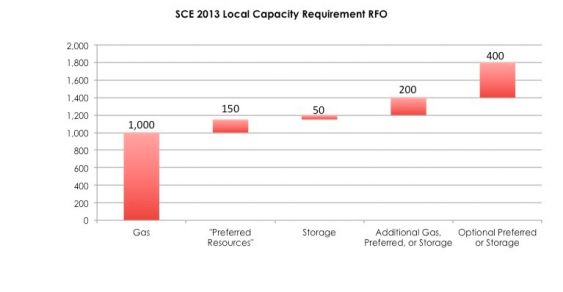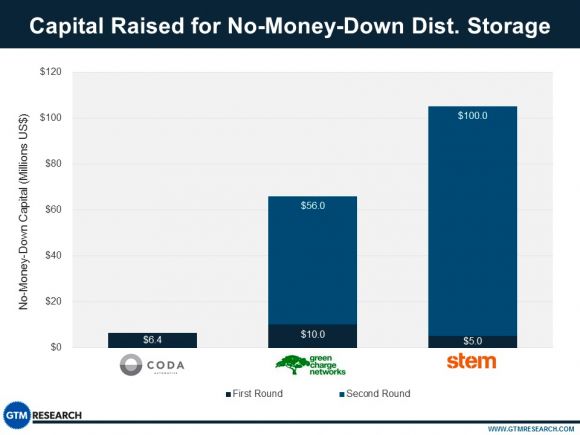Southern California Edison just revealed the list of energy storage companies it has selected to help meet local capacity requirements.
"Its a big, big announcement," said Stem CEO John Carrington.
It's going to be a big week for the energy storage industry. Southern California Edison (SCE) just announced its latest procurement contract -- and energy storage is a major winner. GTM expects to see more than 250 megawatts of energy storage projects selected for this RFO.
It's certainly a big week for Stem, which was selected to provide 85 megawatts of distributed storage to serve as flexible capacity in the West Los Angeles Basin. This is the first time behind-the-meter storage is going head to head with traditional assets on this scale, and it has implications for other regions looking to tackle grid congestion.
We reported on the original RFO, characterizing it as the starting gun signaling the launch of the grid-scale energy storage market.
As GTM reported, the California Public Utilities Commission asked SCE to source more than 50 megawatts of energy storage in the Los Angeles area over the next eight years. (There is also a 1.3-gigawatt target for energy storage to be installed in California by 2020.)
In September 2013, SCE issued a request for a significant amount of new capacity, including the potential 50 megawatts (optionally up to 650 megawatts) of energy storage. It's called the Local Capacity Requirements Request for Offer, or LCR RFO. The RFO is in response to the anticipated loss of once-through cooling generating units and the loss of the San Onofre Nuclear Generating Station.
Although 50 megawatts is a small fraction of the 1,400 to 1,800 megawatts of generation that SCE will procure between now and 2021, it's one of the earliest attempts to craft an RFO aimed at large-scale energy storage. As such, the regulators, utilities, and energy storage bidders are learning as they go and creating metrics and language that suit the unique nature of energy storage.
"Energy storage is new for all of us," said Rosalie Roth, senior contract originator and energy storage product lead at SCE, during a webinar last year. As to what type of technology SCE is looking for, Roth said, "Show us what you've got." She noted, "This RFO is complex -- it's going to be a challenging solicitation." She also said that all qualified resources are encouraged to participate and communicate, adding, "We are figuring it out along the way."
Here’s a chart summarizing the authorized procurement totaling 1,400 to 1,800 megawatts, with what could range from 50 megawatts to 650 megawatts of energy storage.

The 85-megawatt local capacity procurement means Stem must identify customers in specific geographies for its behind-the-meter energy storage system. All 85 megawatts must be deployed by 2021. Stem CEO Carrington notes that the firm has a bigger system rolling out in the first quarter of next year.
Carrington also notes that Stem has experience with interconnection in all of California's IOU territories, adding that there has been an $800 interconnect charge for its systems.
Carrington continued, "Other than interconnection issues, I think SCE is highly motivated to make this work." He added that the distributed nature of the small energy storage systems helps to "avoid single points of failure," "reduces project development risk and improves grid stability and ratepayer happiness."
He sees this RFO as evidence that the IOUs are sending "a clear message about their willingness to look at behind-the-meter storage." He said, "We're confident the demand-charge reduction will be in addition to the DR payment" received by the customer.
Stem has already been aggregating its behind-the-meter batteries for a distributed resource demand-response pilot project with Pacific Gas & Electric and California grid operator CAISO. Carrington noted that several of hotel chain Extended Stay America’s properties in San Francisco and San Mateo counties will be potential participants in that program.
Eventually, “we could put thousands of our systems in buildings throughout a highly congested area and serve as a virtual peaker plant,” he added. That’s the business model that AES Energy Storage is targeting with its large-scale energy storage systems, which could be cost-competitive with natural-gas-fired peaker plants, especially for regions where building new power plants is a challenge because of emissions or land-use constraints. While Stem hasn’t put together a sufficient number of distributed batteries to match the scale of a peaker plant yet, Carrington noted that the company’s “gym-locker-sized” units are much simpler to install than a pad-mounted, utility-scale battery system, at least at individual buildings.
Hotel chain Extended Stay America is installing Stem’s lithium-ion batteries and control systems in 68 of its hotels in California, which is the state with the most lucrative incentives for customer-sited energy storage. While Stem didn’t disclose just how large each of its installations would be, the company designs its products in scales of 18 kilowatts to 54 kilowatts. That means that Stem could be installing between 1.2 megawatts and 3.6 megawatts of batteries with this project, compared to the roughly 6 megawatts of projects the startup had installed or contracted as of this summer. Under Stem’s no-money-down leasing program, Extended Stay will pay for the systems through a monthly fee, and cover those costs through the utility bill reductions the sites will achieve by avoiding demand charges.
Stem just secured $100 million to finance installations under this no-money-down program. Green Charge Networks has raised $56 million for its own shared-savings program, and Coda Energy, the once-bankrupt EV maker bought by investment firm Fortress Investment Group last year, has financed about $6.4 million in installations, with plans to expand that to $25 million.




